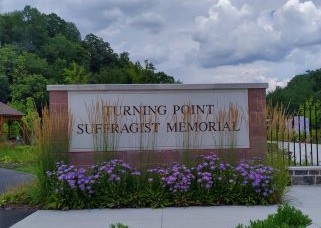by Ann Marie Morrow, AWC Finland

Willing to die for their right to vote
The women’s suffrage movement in the US is as old as the country. When the USA was created, white male landowners were given the right to vote. Other groups have had to continually fight for this right.1
I visited one memorial to the suffragists in that battle that is located near the site of an event that in 1917 became the “turning point” for 25 million American women in winning that fight for the right to vote.
Turning Point Suffragist Memorial, Occoquan Regional Park, Fairfax County, northern Virginia
FAWCO and FAUSA are proud contributors to the building of this memorial. A contribution was also made in the name of longstanding voting rights advocate and FAWCO US Liaison, the late Lucy Stensland Laederich. The memorial was unveiled in 2021, delayed a year by COVID-19. Its intended reveal was to be on the 100-year anniversary of the passage of the 19th Amendment.
 Donor Wall with FAWCO and FAUSA listed
Donor Wall with FAWCO and FAUSA listed
The Turning Point
T Mr. President: How long must women wait for liberty?he suffragist movement to gain the right to vote did not slow down despite WWI raging around the world. Indeed, members of the movement used the US involvement in the war to highlight what they felt was the hypocrisy of the president and government “fighting for freedom” overseas while denying women the freedom to vote and participate in government at home.
Mr. President: How long must women wait for liberty?he suffragist movement to gain the right to vote did not slow down despite WWI raging around the world. Indeed, members of the movement used the US involvement in the war to highlight what they felt was the hypocrisy of the president and government “fighting for freedom” overseas while denying women the freedom to vote and participate in government at home.
In 1917, silent pickets were formed to gather in front of the White House gates. On November 14, 1917, police were called to arrest the picketers. This had happened before, but this time the treatment of the women was especially harsh. They were brought to a prison, the Occoquan Workhouse, where they were beaten and denied food and medical treatment for 36 hours. Women who went on hunger strike in protest were brutally force-fed and treated horribly. News outlets covered this “night of terror” and its aftermath, and the public was appalled at the treatment of the suffragists. For years the administration of Woodrow Wilson and the government had rejected allowing women the right to vote. Now the tide was turned: this event became the turning point in the battle. President Wilson came out in favor of an amendment just two weeks later.
The 19th Amendment was finally ratified by the states in 1920 and became law after decades of protests and battles.
Today
The Memorial shares the often untold story of the suffragist movement on 19 plaque storyboards. It also features an actual section of the White House fence where they protested and were arrested. There are three bronze statues of women important to the movement: Alice Paul, co-founder of the National Woman’s Party and author of the Equal Rights Amendment; Mary Church Terrell, co-founder of the NAACP and professor; and Carrie Chapman Catt, President of the National American Woman Suffrage Association and founder of the League of Women Voters.
There is a wall dedicated to the women arrested that night in 1917 and replicas of the prison door pin that Alice Burns made for fellow members who survived being jailed for the cause.

So few memorials exist celebrating women – less than 8% in public spaces in the US. I wish this memorial were more centrally located in the DC area to help elevate the suffragist story. But it is a beautiful space and does a fabulous job of providing information about the struggle to gain a right so many of us take for granted.
Not everyone has had the right to vote, even in recent history. This memorial educates, inspires, and empowers present and future generations to remain vigilant in the quest for equal rights.
 Ann Marie and the Ballot Box
Ann Marie and the Ballot Box
The right of citizens of the United States to vote shall not be denied or abridged by the United States or by any State on account of sex. – Nineteenth Amendment of the US Constitution, certified August 26, 1920
(August 26 is celebrated as Women’s Equality Day in the US to honor the signing of the 19th Amendment on that date.)
Reference
1. Abigail Adams quote: “Remember the Ladies”
In a letter dated March 31, 1776, Abigail Adams writes to her husband, John Adams, urging him and the other members of the Continental Congress not to forget about the nation’s women when fighting for America’s independence from Great Britain.
The future First Lady wrote in part, “I long to hear that you have declared an independency. And, by the way, in the new code of laws which I suppose it will be necessary for you to make, I desire you would remember the ladies and be more generous and favorable to them than your ancestors. Do not put such unlimited power into the hands of the husbands. Remember, all men would be tyrants if they could. If particular care and attention is not paid to the ladies, we are determined to foment a rebellion, and will not hold ourselves bound by any laws in which we have no voice or representation.”
Photos by AMM
To visit the Turning Point Suffragist Memorial and learn more:
https://suffragistmemorial.org/
https://www.novaparks.com/parks/turning-point-suffragist-memorial
